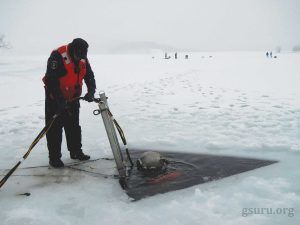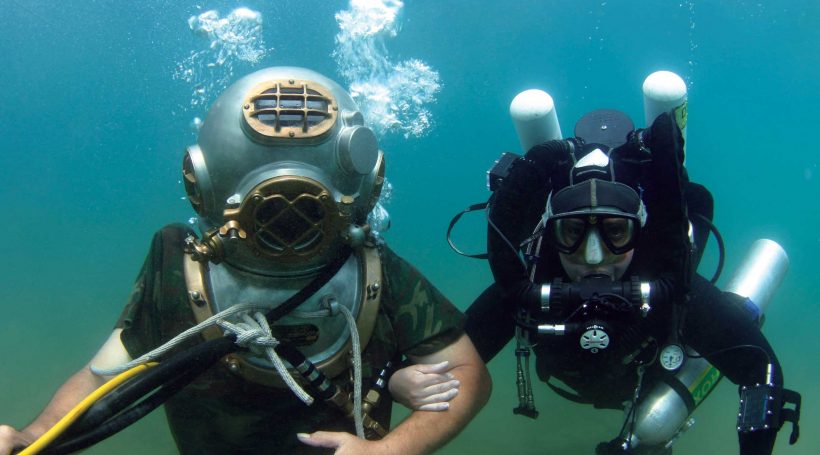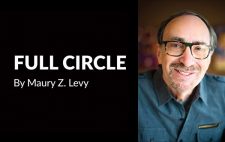After 21-year-old West Chester University student Shane Montgomery disappeared from Manayunk last year, in the early morning hours of Thanksgiving Day, his family, friends and volunteers joined the police and FBI in an exhaustive search that eventually focused on the nearby Schuylkill River.
Police marine units searched the river to no avail, and after several weeks, law enforcement had to give up. The Montgomerys then turned to the Garden State Underwater Recovery Unit (GSURU), a group of divers from New Jersey that seems to do the impossible when they recover drowning victims who are difficult to find – at no cost to the family.
“Local law enforcement has to put limits on their searches,” says Sunny Longordo, president of the recovery unit. “They don’t have a choice, really, but to move on. They can’t put all their resources on a certain case indefinitely. If somebody you love drowns, there’s a period of time when you have 1,000-percent support, and then there’s a time when they say, ‘I’m sorry, we have to stop.’ And then you think, ‘Well what do I do now?’ You call us.”

The unit practices for rescues in all possible weather conditions
Longordo and other members of the GSURU put together a dive team and traveled to Philadelphia from their headquarters in Milford. On Dec. 23, they retrieved a set of keys that belonged to Shane.
“We don’t always come in these cases, where no one knows for sure if there’s a person in the river,” Longordo says. “In this particular case, we thought there was enough evidence for us to take a preliminary look. So we went there that first day with a couple of divers, and they came up with the keys.”
Longordo says the Montgomery family was initially unsure whether the keys belonged to Shane. They drove to their home a mile away and tried the keys in the door. They fit.
“That was so bad,” Longordo says. “The detective and I were bawling our eyes out. It was a very sad situation, because at that point, they knew for sure their son was in the river. There’s no joy in that. You achieve the objective, but there’s no joy in it.”
On Jan. 3, more than a month after Shane Montgomery was reported missing, the Garden State dive team recovered his body. Longordo says she is grateful the team was able to preserve Shane’s dignity and protect his family from more unnecessary suffering.
“In the absence of divers, there are two possible ways for a person to be recovered,” Longordo explains. “Eventually, gases in the victim’s body will build up and the body becomes buoyant and floats. And what the family – who are undoubtedly on the riverbank – see is a bloated body. The other way is teams put grappling hooks on the back of their boats. Eventually the hooks catch on the person. That’s terrible too – you don’t want to think of your loved one being pulled up like a fish. When we say we recover people with dignity that means finding them, taking a body bag out and putting them into the bag in the water. In the case of Shane, the family was 15 feet away and didn’t see a thing. I think they’ll look back on it and be glad they didn’t see.”
The Garden State Underwater Recovery Unit was officially formed in 1960, making it one of the oldest recovery diving teams in the country. The approximately 25 members of the team span the ages of 18 to 60 and come from all walks of life.
“We have every background imaginable,” Longordo says. “We have a Wall Street executive, a pharmacist, a law enforcement officer, a mortician. I’m a marketing executive. We’re a diverse group of people, but we’re connected by the fact that we’re divers. We all have some connection to it, some reason for wanting to do what we do.”
Longordo got involved with the recovery unit in 2007 after a trip to Canada. She and another member witnessed an accident that resulted in a drowning victim being stuck under the ice.
“We found out there wasn’t anyone who was going to go get him,” Longordo remembers. “They were just going to wait until spring when things thawed out. We were like, ‘Get out of here, this family is freaking out!’ So we waited there for six hours until they let us go in and get him, and when we got home we said we had to keep this from happening in New Jersey. That’s when we founded the unit.”
The group, most of whom have families and full-time jobs, meets every Thursday night and spends at least two weekends a month doing practice drills. But no matter how often they practice, Longordo says, it’s impossible to prepare a diver for their first recovery mission.
“We practice everything imaginable,” she says. “How do you decontaminate your gear? How do you recover a victim without contaminating evidence? How do you put a deceased person in a basket to pull them out? The topics are pretty wide-ranging but there’s no way to prepare for the first time you see a drowning victim up close. You’re never expecting it, even though you know it’s there.”
On average, the GSURU responds to a dozen calls from families like Shane Montgomery’s every year. The equipment, travel costs and recovery operations can be expensive, but the team never charges for its services. They operate solely from their own pockets and with the help of donations. One of their biggest supporters is Stacey Hudicek, who met Sunny Longordo under tragic circumstances in 2012.
Hudicek’s brother Joseph “Babe” McGeehan left a Philadelphia bar on Jan. 7, 2012, on his way to pick up a friend from a nearby yacht club. He never arrived. Hudicek, the oldest of 10 siblings, said her tight-knit family knew right away that something was wrong, but police couldn’t file a missing person report until two days had passed.
“When he didn’t show up where he was supposed to, we went into full detective mode,” Hudicek says. “We knew where he was leaving and where he was headed, and that narrowed down the area we were searching.”
The family found tire marks in the gravel and on a log at the end of Unruh Avenue, which dead-ends at the Delaware River. At the time, there was nothing but a low berm between the road and a 10-foot drop into the water.
“There were no lights there, no poles, nothing to alert a driver that the road was going to end,” Hudicek says. “The tire tracks went right into the Delaware.”
The family obtained security footage from a nearby business that showed McGeehan’s Jeep Liberty hurtling into the river. Police marine units responded and prepared to pull the vehicle and its driver out of the water. The recovery, however, proved to be difficult.
“The visibility was low, and the marine divers couldn’t see well,” Hudicek says. “The truck flipped when it went in and was resting on the hood with the nose facing the shore. My brother must have realized what was about to happen and tried to get out, because the window was halfway down. When they flipped the truck to pull it out, my brother’s body went out the window.”
Hudicek and her family were horrified when police told them another recovery attempt would be too dangerous.
“Once the truck was out, they didn’t go back in the water,” she says. “They weren’t going to risk their lives to recover him. Why they’d take the risk for a vehicle and not a person, my family and I will never understand.”
The family stayed at the river’s edge for 15 days. Television crews and newspapers covered their plight, and strangers showed up with warm beverages and food, joining the family in their vigil.
“We’d been told that eventually his body would rise to the surface, and he would float downstream,” Hudicek says. “I never wanted to leave the water. I was so afraid that would happen and I would miss him, and we’d have to wait for months or maybe even never get my brother back. It’s the worst feeling in the world to know they’re in that water. You know they’re gone, and you just have to get them out.”
Two other local recovery units joined the family at the scene, but the water conditions were too dangerous for a dive. Hudicek was growing desperate when she received a call from the GSURU.
“When I did go home, I would call different places, and no one could help,” Hudicek says. “On Jan. 20, I got a call from Sunny Longordo. She explained everything they were going to attempt. I felt that night in my heart that he was coming home, and they were going to get him back to me. I went down to the river before I went to bed and said, ‘Babe, don’t go nowhere. We’re coming, and we’re going to get you out in the morning.” Sunny put together a nine-person dive team and they left Milford at 4 am the next day.
Not even an hour after the GSURU dive team entered the water, they found McGeehan’s body, less than 15 feet from the shore.
“You can never repay them for giving you what they do,” Hudicek says. “They didn’t know us. It was freezing and snowing. That water was so cold. But they were so graceful about the whole situation, and after they got him out I walked up to Sunny, hugged her, and then they left. They didn’t want money, they didn’t want recognition, they didn’t want anything. They gave us our privacy and left us to mourn.”
Hudicek says that without the efforts of the GSURU, her family may never have found closure after her brother’s death.
“When you lose a family member like that, they die twice,” she says. “They die the day you confirm they’re in that water and again the day you pull them out. If we’d never gotten him out, we never could have started the healing process.”
In the three years since McGeehan’s death, Hudicek and her family have hosted an annual beef and beer to raise money for the recovery unit. She and Longordo have developed a close friendship.
“Of course I wish we’d met under different circumstances, but I talk to Sunny almost every day. She comes to family weddings and birthday parties,” Hudicek says. “Every year we’ll hold the benefit, raise money and spread the word about the recovery unit. I know we can’t pay for everything, but as long as I’m breathing, they’ll be OK.”
Longordo hopes the attention the Shane Montgomery case brought the GSURU will allow them to help other families who are in need of their recovery services. Though the job is emotionally taxing, she wants to ensure that no family suffers longer than they need to.
“It’s not easy to do,” Longordo says. “You carry it around with you. I cried buckets for Shane Montgomery. I cried buckets for Babe McGeehan. I cried buckets for the person before him and the person before him. But when it comes to the work we do, we are providing peace and comfort for families that have been through an unimaginable loss. Maybe we’ll grow and this will become a big thing with additional chapters in more towns, but what we’ll always do is what we’ve always done: help when we’re the only ones who can.”












